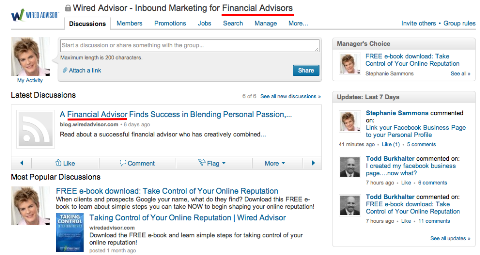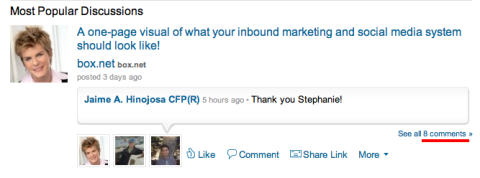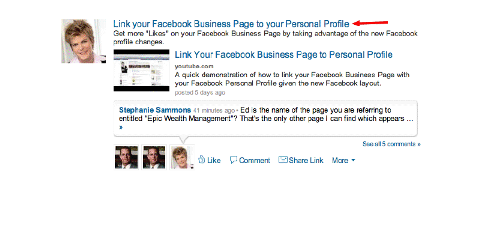 If you want to build truly influential relationships online, you have to find places where you can consistently add value, spend quality time and have engaging conversations with members of your target demographic.
If you want to build truly influential relationships online, you have to find places where you can consistently add value, spend quality time and have engaging conversations with members of your target demographic.
LinkedIn Groups offers one of the best ways to make the most of your social media engagement time, but you must adopt the right strategy to be successful. This article will show you how.
LinkedIn allows you to join up to 50 groups, but you can't possibly be effective and spend enough time to make a difference in 50 groups.
What works best is to focus your time and effort on a deep and narrow approach in order to build influence within LinkedIn Groups, enhance your credibility and generate new connections.
Here's how:
#1: Identify the Best Group Opportunities
Evaluate the groups you've joined or intend to join and focus on the top 3 to 5 groups that most accurately represent your target demographic. Also, you'll want to choose groups that don't have a huge membership.
I recommend that you choose groups that have at least a few hundred members, but no more than a few thousand if you really want to maximize your visibility.
Plan to proactively visit each of your top groups 2-3 times a week. Don't wait for the daily or weekly updates that come to your email inbox. Identify your best opportunities and plan to make frequent and consistent appearances!

#2: Target the Most Popular Discussions in Each Group
The most “popular” discussions within a group generally get the most visibility. These are the topics where members are most actively engaged and they feature discussions that you will want to weigh in on. The most popular discussions are at the top of the group discussion page, and typically there will be quite a few comments associated with them for you to review and learn from.

As you weigh in on popular discussions, respond to existing comments, provide an insight or opinion or even ask a thought-provoking question to generate additional comments. You can also “Like” and “Share” these discussions with your connections.
If your comments add value to the popular discussions, members will begin to recognize you as a thought leader within the group.
#3: Start Your Own Discussion
Starting your own discussion thread is also a powerful tool within a group, but you must be strategic with this. I recommend that you wait to start your own discussion until after you've spent some time participating in the top discussions first (#2).
In addition, observe the contributions of the most active group members in order to understand their concerns, goals and objectives. What seems to be important to them?
Also study prior popular discussions. What topics have resonated with members? In starting your own discussion, pose a question, ask for help or advice or post a relevant and interesting article or resource for the group's benefit. Your goal with starting your own discussion is to encourage as much engagement as possible!
Get World-Class Marketing Training — All Year Long!
Are you facing doubt, uncertainty, or overwhelm? The Social Media Marketing Society can help.
Each month, you’ll receive training from trusted marketing experts, covering everything from AI to organic social marketing. When you join, you’ll also get immediate access to:
- A library of 100+ marketing trainings
- A community of like-minded marketers
- Monthly online community meetups
- Relevant news and trends updates

Discover Proven Marketing Strategies and Tips
Want to go even deeper with your marketing? Check out the Social Media Marketing Podcast! Publishing weekly since 2012, the Social Media Marketing Podcast helps you navigate the constantly changing marketing jungle, with expert interviews from marketing pros.
But don’t let the name fool you. This show is about a lot more than just social media marketing. With over 600 episodes and millions of downloads each year, this show has been a trusted source for marketers for well over a decade.


If you're truly engaging members of the group with the discussions you initiate, you'll have the opportunity to be recognized as a “Top Influencer” in the group page sidebar, which can help you build visibility and authority within the group.

Note: It's extremely important to add value when starting discussions and avoid promoting your own products, services or content. After you've earned some credibility within your top groups, it's acceptable to post one of your own articles from time to time. Just make sure that what you post to the group answers a question or solves a problem with members, and don't ever post sales-related material.
#4: Follow Up and Follow Through
One of the disadvantages of LinkedIn Groups is that it's difficult to keep up with updates unless you proactively visit your top groups as recommended. Make sure to keep up with the conversations you're participating in.
Don't let too much time lapse and don't leave a conversation open. Keep your comments fresh and interesting to demonstrate your commitment to your groups.
Also consider handing out “Likes” for interesting posts by group members and share valuable posts as LinkedIn status updates. When you share a group discussion post as a status update, you're exposing it to all of your connections and giving the post greater visibility within LinkedIn. Promoting and connecting others on LinkedIn can build social influence.
#5: Start Your Own Group
If you're willing to make the commitment, another option is to start your own LinkedIn Group. If you manage your own group, you have control over many aspects of your group. To an extent, you can control which discussions get more visibility through the “Manager's Choice” feature.

As the founder of the group, it's actually your job to lead discussions with the group! Ultimately it will be the members who push the most interesting discussions to the top. When you start your own group, make sure that you have a well-defined niche or theme. Otherwise you may not get much traction. Focus on bringing people together who can benefit from sharing mutual experiences and insights.
Using this approach for your LinkedIn Group participation strategy can help you maximize your time and energy on the network. Making a commitment to adding value to a small number of targeted groups on a consistent basis will help you build influence and new connections. In addition, you'll find that there's little competition in this strategy!
What strategies are you currently using within LinkedIn Groups? Are you finding relevant groups for your industry where you can truly add value? I would love to hear about your experiences. Leave your comments in the box below.
Attention Agency Owners, Brand Marketers, and Consultants

Introducing the Marketing Agency Show–our newest podcast designed to explore the struggles of agency marketers.
Join show host and agency owner, Brooke Sellas, as she interviews agency marketers and digs deep into their biggest challenges. Explore topics like navigating rough economic times, leveraging AI, service diversification, client acquisition, and much more.
Just pull up your favorite podcast app, search for Marketing Agency Show and start listening. Or click the button below for more information.

